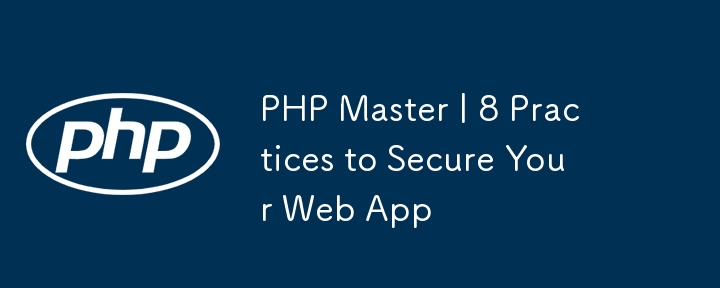Home >Backend Development >PHP Tutorial >PHP Master | 8 Practices to Secure Your Web App
PHP Master | 8 Practices to Secure Your Web App
- Lisa KudrowOriginal
- 2025-02-24 10:48:11568browse

Building secure web applications requires more than just hardware and platform security; it demands secure coding practices. This article outlines eight crucial habits for developers to minimize vulnerabilities and protect their applications from attacks.
Key Security Practices:
- Input Validation: Never trust user input. Always validate and sanitize all incoming data to prevent malicious code injection. Client-side validation (e.g., JavaScript) is helpful but insufficient; server-side validation in PHP is crucial.
-
XSS (Cross-Site Scripting) Protection: Prevent XSS attacks by removing HTML tags from user input using
strip_tags()and escaping HTML entities usinghtmlentities()before displaying data to the browser. - CSRF (Cross-Site Request Forgery) Prevention: Use POST requests for actions that modify data (avoid GET requests for such operations). Implement CSRF tokens—unique, session-specific tokens—to verify that requests originate from legitimate users.
- SQL Injection Prevention: Employ parameterized queries and prepared statements (using PDO) to prevent attackers from injecting malicious SQL code into database queries.
- File System Protection: Avoid directly serving files based on user-supplied filenames. Implement strict access controls to prevent unauthorized access to arbitrary directories.
- Session Data Security: Avoid storing sensitive information (passwords, credit card details) directly in sessions. Encrypt session data and consider using a database for session persistence.
-
Robust Error Handling: Configure your server to handle errors differently in development and production environments. Hide error details from users in production, but log errors for debugging. Use exception handling (
try/catchblocks) for graceful error management. -
Secure Included Files: Always use the
.phpextension for included files and store them outside of publicly accessible directories to prevent direct access and potential exposure of sensitive information.
Frequently Asked Questions (FAQs):
This section addresses common web application security concerns and provides concise answers.
Q: What are common web application vulnerabilities?
A: Common vulnerabilities include Cross-Site Scripting (XSS), SQL Injection, Cross-Site Request Forgery (CSRF), and insecure direct object references.
Q: How do I prevent SQL Injection?
A: Use parameterized queries or prepared statements and always validate and sanitize user input.
Q: What is XSS and how can I prevent it?
A: XSS involves injecting malicious scripts. Prevention involves input validation, escaping output, and implementing a Content Security Policy (CSP).
Q: How do I secure user authentication?
A: Use strong password policies, multi-factor authentication, secure password storage (hashing and salting), and HTTPS.
Q: What is CSRF and how do I prevent it?
A: CSRF tricks users into performing unwanted actions. Prevention involves CSRF tokens and the SameSite cookie attribute.
Q: How do I protect sensitive data?
A: Encrypt data at rest and in transit, implement access controls, and regularly audit your application.
Q: What are insecure direct object references?
A: These occur when an application directly accesses objects based on user input. Prevention involves access control checks and indirect referencing.
Q: How do I ensure secure communication?
A: Use HTTPS and HSTS.
Q: What are best practices for web application security?
A: Regular updates, secure coding, strong access control, data encryption, and regular security audits.
Q: How do I monitor for security threats?
A: Use intrusion detection systems, audit your application, monitor logs, and consider a SIEM system.
By diligently following these eight practices and addressing the common vulnerabilities outlined above, developers can significantly enhance the security of their PHP applications. Remember, prioritizing security from the outset is crucial for building robust and trustworthy web applications.
The above is the detailed content of PHP Master | 8 Practices to Secure Your Web App. For more information, please follow other related articles on the PHP Chinese website!

